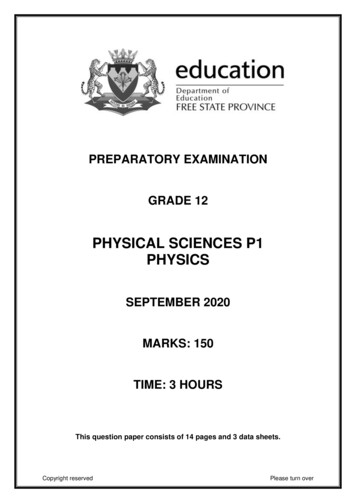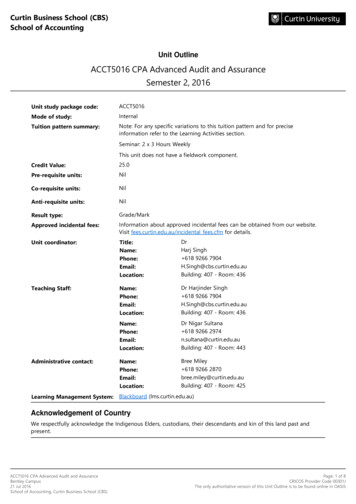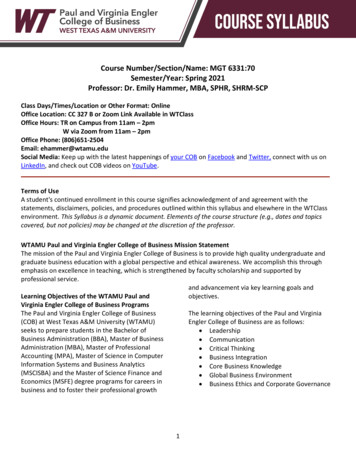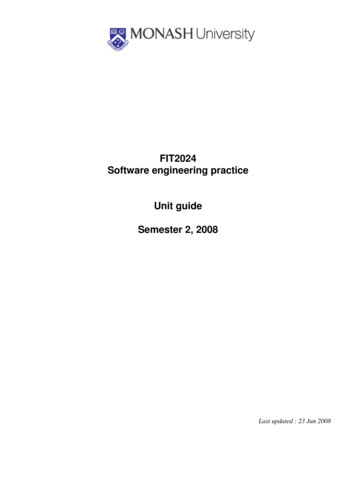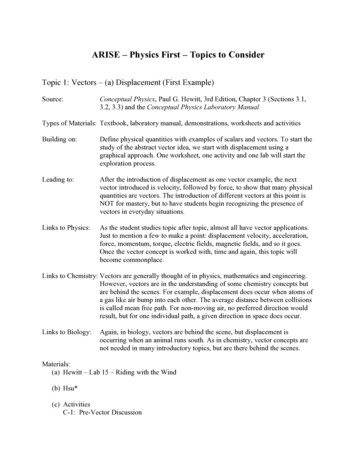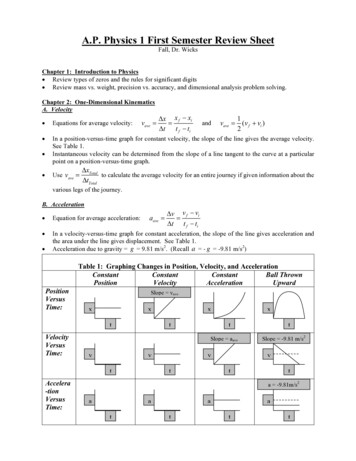
Transcription
A.P. Physics 1 First Semester Review SheetFall, Dr. WicksChapter 1: Introduction to Physics Review types of zeros and the rules for significant digits Review mass vs. weight, precision vs. accuracy, and dimensional analysis problem solving.Chapter 2: One-Dimensional KinematicsA. Velocityvave Dx x f - xi Dt t f - t i1vave (v f vi )2 Equations for average velocity: In a position-versus-time graph for constant velocity, the slope of the line gives the average velocity.See Table 1.Instantaneous velocity can be determined from the slope of a line tangent to the curve at a particularpoint on a position-versus-time graph. Use vave andΔxTotalto calculate the average velocity for an entire journey if given information about theΔtTotalvarious legs of the journey.B. Accelerationaave Dv v f - vi Dt t f - ti Equation for average acceleration: In a velocity-versus-time graph for constant acceleration, the slope of the line gives acceleration andthe area under the line gives displacement. See Table 1.Acceleration due to gravity g 9.81 m/s2. (Recall a - g -9.81 m/s2) Table 1: Graphing Changes in Position, Velocity, and AccelerationConstantConstantConstantBall rsusTime:Slope vavexxtVelocityVersusTime:txtSlope aavevvtAccelera-tionVersusTime:xvttSlope -9.81 m/s2vtta -9.81m/s2aatatatt
A.P. Physics 1 First Semester Review Sheet, Page 2Table 2: Comparing the Kinematic EquationsKinematic EquationsMissing Variablex xo vavetav vo atDx1x xo vot at 22v finalv 2 vo 2 2aDxDtChapter 3: Vectors in PhysicsA. Vectors Vectors have both magnitude and direction whereas scalars have magnitude but no direction. Examples of vectors are position, displacement, velocity, linear acceleration, tangential acceleration,centripetal acceleration, applied force, weight, normal force, frictional force, tension, spring force,momentum, gravitational force, and electrostatic force. Vectors can be moved parallel to themselves in a diagram. Vectors can be added in any order. See Table 3 for vector addition. rat angle q to the x-axis, the x- and y-components forΔx r cosθ and Δy r sin θ . For vector The magnitude of vectornearest x-axis is risr Δx 2 Δy 2 rcan be calculated fromand the direction angle for rrelative to the Δy θ tan 1 . Δx To subtract a vector, add its opposite.Multiplying or dividing vectors by scalars results in vectors.In addition to adding vectors mathematically as shown in the table, vectors can be added graphically.Vectors can be drawn to scale and moved parallel to their original positions in a diagram so that theyare all positioned head-to-tail. The length and direction angle for the resultant can be measured with aruler and protractor, respectively.B. Relative Motion Relative motion problems are solved by a special type of vector addition. v13 v12 v 23 For example, the velocity of object 1 relative to object 3 is given by2 can be anything. Subscripts on a velocity can be reversed by changing the vector’s direction:where object v12 v 21
A.P. Physics 1 First Semester Review Sheet, Page 3Vector OrientationVectors are parallel:Vectors are perpendicular:Table 3: Vector AdditionCalculational Strategy UsedAdd or subtract the magnitudes (values) to get the resultant.Determine the direction by inspection.Use the Pythagorean Theorem, Dx 2 Dy 2 r 2 , to get theresultant, r , where Dx is parallel to the x-axis and D y isparallel to the y-axis.æ Dy ö to get the angle, q , made with the x-axis.è Dx øUse q tan -1 çVectors are neither parallelnor perpendicular:Adding 2 VectorsLimited usefulness(1) Use the law of cosines todetermine the resultant:c 2 a 2 b2 - 2ab cos q(2) Use the law of sines tohelp determine direction:abc sin A sin B sin CAdding 2 or More Vectors(Vector Resolution Method)Used by most physicists(1) Make a diagram.(2) Construct a vector table.(Use vector, x-direction,and y-direction for thecolumn headings.)(3) Resolve vectors usingΔx r cosθ andΔy r sin θ whenneeded.(4) Determine the signs.(5) Determine the sum of thevectors for each direction,Dxtotal and Dytotal .(6) Use the Pythagorean Thmto get the resultant, r :Dxtotal 2 Dytotal 2 r 2æ Dytotal ö toè Dxtotal øget the angle, q .(7) Useq tan -1 ç
A.P. Physics 1 First Semester Review Sheet, Page 4Chapter 4: Two-Dimensional KinematicsA. Projectile Motion See Table 4 to better understand how the projectile motion equations can be derived from the kinematicequations. The kinematic equations involve one-dimensional motion whereas the projectile motion equationsinvolve two-dimensional motion. Two-dimensional motion means there is motion in both thehorizontal and vertical directions. Recall that the equation for horizontal motion (ex. Dx vx Dt ) and the equations for vertical motion(ex. v y , f - g Dt , Dy - 1g (Dt )2 , vy2, f -2 g Dy ) are independent from each other.2 Recall that velocity is constant and acceleration is zero in the horizontal direction. Recall that acceleration is g 9.81 m/s2 in the vertical direction.When projectiles are launched at an angle, the range of the projectile is often calculated from1Δx (vi cosθ )Δt and its time of flight is often calculate from Dy (vi sin q )Dt - g (Dt ) 2 .2æ g öProjectiles follow a parabolic pathway governed byy h - ç 2 x2è 2vo øTable 4: Relationship Between the Kinematic Equations and Projectile Motion EquationsKinematic EquationsMissingProjectile Motion,Projectile Motion,VariableZero Launch AngleGeneral Launch AngleAssumptions made:Assumptions made:a - g and vo , y 0a - g , vo , x vo cos q ,and vo , y vo sin q x xo vavetaDx vxtwhere vx const.Dx (vo cos q )twhere vx const.v vo atDxv y - gtv y vo sin q - gt1x xo vot at 22v final1Dy - gt 221Dy (vo sin q )t - gt 22v 2 vo 2 2aDxDtvy 2 -2 g Dyvy 2 vo 2 sin 2 q - 2 g Dy For an object in free fall, the object stops accelerating when the force of air resistance, F Air , equals the weight, W . The object has reached its maximum velocity, the terminal velocity.When a quarterback throws a football, the angle for a high, lob pass is related to the angle for a low,bullet pass. When both footballs are caught by a receiver standing in the same place, the sum of thelaunch angles is 90o.In distance contests for projectiles launched by cannons, catapults, trebuchets, and similar devices,projectiles achieve the farthest distance when launched at a 45o angle.
A.P. Physics 1 First Semester Review Sheet, Page 5 æ vo 2 ö sin 2qè g øThe range of a projectile launched at initial velocity vo and angle q is R çThe maximum height of a projectile above its launch site isymaxvo 2 sin 2 q 2gChapter 5: Newton’s Laws of MotionTable 5: Newton’s Laws of MotionModern Statement for LawTranslationNewton’s First Law:If the net force on an object is An object at rest will remain at(Law of Inertia)zero, its velocity is constant.rest. An object in motion willRecall that mass is a measure ofremain in motion at constantinertia.velocity unless acted upon by anexternal force.Newton’s Second Law:An object of mass m has an F ma netacceleration a given by the net F divided by m . That Fis a mforceNewton’s Third Law:Recall action-reaction pairsFor every force that acts on anobject, there is a reaction forceacting on a different object that isequal in magnitude and oppositein direction.For every action, there is anequal but opposite reaction.A. Survey of Forces A force is a push or a pull. The unit of force is the Newton (N); 1 N 1 kg-m/s2 See Newton’s laws of motion in Table 5. Common forces on a moving object include an applied force,a frictional force, a weight, and a normal force. Contact forces are action-reaction pairs of forces produced by physical contact of two objects. Reviewcalculations regarding contact forces between two or more boxes. Field forces like gravitational forces, electrostatic forces, and magnetic forces do not require directcontact. They are studied in later chapters. Forces on objects are represented in free-body diagrams. They are drawn with the tails of the vectorsoriginating at an object’s center of mass. Weight, W , is the gravitational force exerted by Earth on an object whereas mass, m , is a measure ofthe quantity of matter in an object ( W mg ). Mass does not depend on gravity. Apparent weight, W a , is the force felt from contact with the floor or a scale in an accelerating system.For example, the sensation of feeling heavier or lighter in an accelerating elevator. The normal force, N , is perpendicular to the contact surface along which an object moves or is capable of moving. Thus, for an object on a level surface, N and W are equal in size but opposite in direction.However, for an object on a ramp, this statement is not true because N is perpendicular to the surfaceof the ramp. Tension, T , is the force transmitted through a string. The tension is the same throughout the length ofan ideal string.
A.P. Physics 1 First Semester Review Sheet, Page 6 The force of an ideal spring stretched or compressed by an amount x is given by Hooke’s Law, F x kx . Note that if we are only interested in magnitude, we use F kx where k is the spring orforce constant. Hooke’s Law is also used for rubber bands, bungee cords, etc.Chapter 6: Applications of Newton’s LawsA. Friction Coefficient of static friction µ S FS ,max where F S ,max is the max. force due to static friction.N FCoefficient of kinetic friction µ K K where F K is the force due to kinetic friction.NA common lab experiment involves finding the angle at which an object just begins to slide down aramp. In this case, a simple expression can be derived to determine the coefficient of static friction:µS tan q . Note that this expression is independent of the mass of the object.B. Newton’s Second Law Problems (Includes Ramp Problems)1. Draw a free-body diagram to represent the problem.2. If the problem involves a ramp, rotate the x- and y-axes so that the x-axis corresponds to the surface ofthe ramp.3. Construct a vector table including all of the forces in the free-body diagram. For the vector table’scolumn headings, use vector, x-direction, and y-direction.4. Determine the column total in each direction:a. If the object moves in that direction, the total is ma .b. If the object does not move in that direction, the total is zero.c. Since this is a Newton’s Second Law problem, no other choices besides zero and ma are possible.5. Write the math equations for the sum of the forces in the x- and y-directions, and solve the problem. Itis often helpful to begin with the y-direction since useful expressions are derived that are sometimeshelpful later in the problem. Recall that the math equations regarding friction and weight are oftensubstituted into the math equations to help solve the problem.C. Equilibrium F 0. An object is in translational equilibrium if the net force acting on it is zero, Equivalently, an object is in equilibrium if it has zero acceleration. If a vector table is needed for an object in equilibrium, then Typical problems involve force calculations for objects pressed against walls and tension calculationsfor pictures on walls, laundry on a clothesline, hanging baskets, pulley systems, traction systems,connected objects, etc. F x 0 and Fy 0.D. Connected Objects Connected objects are linked physically, and thus, they are also linked mathematically. For example,objects connected by strings have the same magnitude of acceleration. When a pulley is involved, the x-y coordinate axes are often rotated around the pulley so that the objectsare connected along the x-axis. A classic example of a connected object is an Atwood’s Machine, which consists of two massesconnected by a string that passes over a single pulley. The acceleration for this system is given byæ m - m1 öa ç 2 g .è m1 m2 ø
A.P. Physics 1 First Semester Review Sheet, Page 7Chapter 7: Work and Kinetic EnergyA. Work A force exerted through a distance performs mechanical work. When force and distance are parallel, W Fdwith Joules (J) or Nm as the unit of work. When force and distance are at an angle, only the component of force in the direction of motion is usedto compute the work:W ( F cos q )d Fd cos q Work is negative if the force opposes the motion ( q 90o). Also, 1 J 1 Nm 1 kg-m2/s2. nIf more than one force does the work, thenWTotal å Wii 111WTotal DK K f - Ki mv 2f - mvi222 The work-kinetic energy theorem states that See Table 6 for more information about kinetic energy. In thermodynamics,æ Aö æ F öW Fd Fd ç ç ( Ad ) PDV for work done on or by a gas.è Aø è AøKinetic Energy TypeTable 6: Kinetic EnergyEquationKinetic Energy as aFunction of Motion:K Kinetic Energy as aFunction of Temperature:3æ1 2öç mv Kave kT2è2øaveCommentsUsed to represent kinetic energyinmost conservationofmechanical energy problems.1 2mv2Kinetic theory relates theaverage kinetic energy of themolecules in a gas to the Kelvintemperature of the gas.B. Determining Work from a Plot of Force Versus Position In a plot of force versus position, work is equal to the area between the force curve and the displacementon the x-axis. For example, work can be easily computed using W Fd when rectangles are presentin the diagram. For the case of a spring force, the work to stretch or compress a distance x from equilibrium is1 2kx . On a plot of force versus position, work is the area of a triangle with base x2(displacement) and height kx (magnitude of force using Hooke’s Law, F kx ).W C. Determining Work in a Block and Tackle Lab The experimental work done against gravity, WLoad , is the same as the theoretical work done by thespring scale, WScale . WOutput WLoad Fd Load W d Load mgd Load WInput WScale Fd Scale where F force read from the spring scale and d Scale distance
Table 1: Graphing Changes in Position, Velocity, and Acceleration Constant Position Constant Velocity Constant Acceleration Ball Thrown Upward Position Versus Time: Velocity Versus Time: Accelera-tion Versus Time: t x t x Slope v ave t x t x t v t v t v Slope a ave t v Slope -9.81 m/s2 t a t a t a t a a -9.81m/s2. A.P. Physics 1 First Semester Review Sheet, Page 2 Table 2: Comparing .

